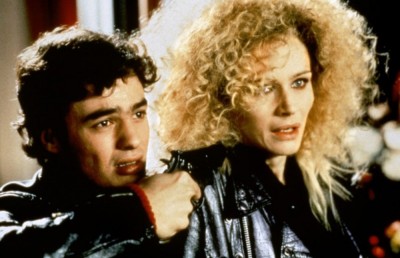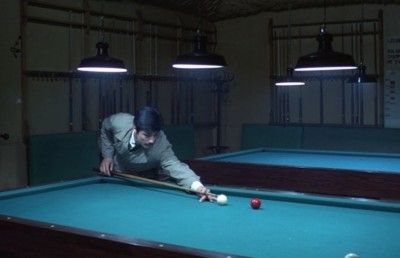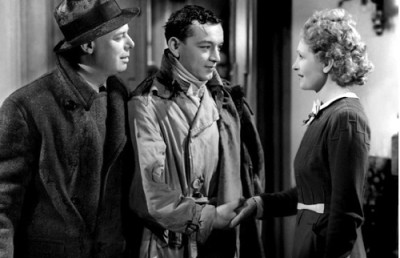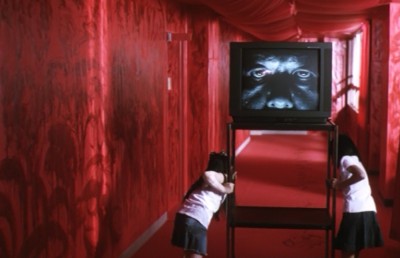The Whole Film Dances: The Criterion Collection edition of Powell and Pressburger’s The Tales of Hoffman
Cinema Does Opera
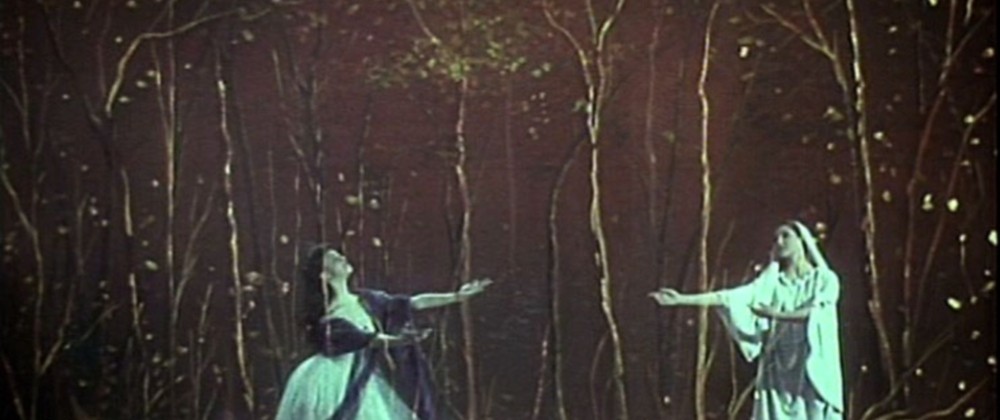
There is a nice little amateur website on British cinema which calls itself It’s Not Just Michael Powell. The name of the site not only underscores the way in which Powell has in recent years become one of the most revered British directors, but also suggests the website author’s exasperation at the manner in which his canonical centrality has (arguably) shifted the spotlight away from other interesting niches of British film history. Yet, while acknowledging the capacity of some critics to ride critical hobby horses, Powell’s films, whether those made under the Archers banner or his solo efforts, constitute a unique and richly imaginative strand within British and indeed world cinema. With their reverence for pictorial beauty, their daring narrative structures, their frequent flights of whimsical fantasy and their celebration of artistic experimentation, these richly layered cinematic texts have provoked deserved attention among scholars and in terms of DVD reissues.

While Milestone Films has issued a DVD edition of Michael Powell’s Edge of the World (1937) with intriguing extras, it is clearly the Criterion collection that has cornered the market on dvd reissues of Powell’s works (with and without Pressburger) that feature impeccable visual and audio transfers of the actual films and fascinating extras of various kinds. The Criterion collection boasts a reissue of Powell’s masterpiece Peeping Tom (1960) and five Archers works thus far, including I Know Where I’m Going (1945); The Life and Death of Colonel Blimp (1946); Black Narcissus (1947); The Red Shoes (1948) and, most recently, The Tales of Hoffmann (1951).
This latest Archers reissue by Criterion is a particularly apt follow up to their lavish edition of The Red Shoes. Like Marcel Carné’s Les Enfants du Paradis (1945), The Red Shoes and The Tales of Hoffmanm are artistically complex films about the worlds of art and artists. These latter two films emerge from a long British Romantic tradition predating cinema itself, one that looks back to such literary figures as Walter Pater and Oscar Wilde and that looks ahead to Derek Jarman. In this tradition, art imitates life and life imitates art in ways that make us powerfully aware of just how fundamental creativity is to the life force. The Red Shoes and Tales of Hoffmann also both exhibit very sophisticated approaches to the process of adaptation. For the script of The Red Shoes Emeric Pressburger took inspiration from a Hans Christian Andersen tale to weave a screenplay that became the framework for a mosaic of dance, music and stunning visual design. ??The Tales of Hoffmann??’s approach to adaptation is even more radical: Jacques Offenbach’s opera, inspired originally by E.T.A. Hoffmann’s stories, is not merely recorded on film, but is totally recast in cinematic terms.
More specifically, The Tales of Hoffmann brings together many of the same creative personnel both behind and in front of the camera, that made The Red Shoes such a commercial and box office success. Moira Shearer, Leonide Massine and Robert Helpmann are again reunited as performers within the film, as are key members of the Red Shoes production team: production designer Hein Heckroth, Sir Thomas Beecham conducting the Royal Philharmonic Orchestra, cinematographer Chris Challis, editor Reginald Mills and camera operator Freddie Francis. Heckroth had won an academy award for his work on The Red Shoes, and as we learn on the Hoffmann disc, he regarded his work on the former film as “child’s play” compared to his work on The Tales of Hoffmann.
Opera is of course an amalgam of most of the traditional arts: dance, music, theatre and painting. The Criterion edition of The Tales of Hoffmann does full justice to Powell and Pressburger’s meticulous attention to all of these strands. The disc offers a high-definition digital transfer from the British Film Institute’s restoration internegative, and to my (admittedly aging) eyes and ears the visual and audio quality are flawless. The care taken in the presentation of this edition of The Tales of Hoffmann is particularly fortunate in the light of the egregious mutilations the film has been subject to, particularly the elimination of the entire ‘Tale of Antonia’ sequence for the film’s original U.S. release.
And, just as opera interweaves several kinds of textuality, this Criterion disc combines different types of textual materials and invites consideration of the relationship between them. The film text can be watched with or without the audio commentary by Martin Scorsese and Bruce Eder. There is also what the Criterion publicity calls a “video essay” interview with George A. Romero; the film’s original theatrical trailer is included, as is an intriguing short film by Powell called The Sorcerer’s Apprentice. Also on the disc itself are two interesting galleries, one of archival production and publicity photographs and one of Hein Heckroth’s illustrations and designs for the production. Finally, the insert booklet that accompanies the disc features a new essay on the film by Powell and Pressburger expert Ian Christie.
The choice of having Martin Scorsese as one of the audio commentators is fortuitous. His status as a genuine champion of the Archers, and of Michael Powell in particular, is well known. Scorsese was instrumental in the mounting of a major retrospective of Powell’s work at the New York Film Festival in 1980 and became Powell’s close friend. The personal connection between the two was certainly solidified when Scorsese’s long time editor, Thelma Shoonmaker, married Powell in 1984. Michael Powell contributed the foreword to Scorsese on Scorcese (!989), and Scorsese mentions Powell numerous times in that book. Scorsese also wrote the forward for a new edition of Ian Christie’s book on Powell and Pressburger, Arrows of Desire (1994) . He even joined Powell and Pressburger on stage at the National Film Theatre when Ian Christie conducted a Guardian Lecture with the filmmakers on July 28, 1985. A transcript of that interview is contained in Michael Powell: Interviews (2003), though it loses some of its power given that the reader is not privy to the film clips that were shown on that occasion.
The fascinating and astute comments by Scorsese on the commentary track can only enhance his reputation as a devotee of Powell and Pressburger’s works. At one point in his discussion Scorsese remarks of The Tales of Hoffmann that “the whole film dances” and, indeed, he proves himself to be an extraordinary close reader of the film, particularly with respect to the choreography of camera movement, movements of actors within the frame, and the movement of the frame itself. Scorsese also makes reference to Powell and Pressburger’s concept of “composed film” whereby not only are all of the elements that comprise the film given detailed attention, but so, too, is the combination of those elements into an harmonious whole. For example, with Scorsese as our guide, it is fascinating to watch the way in which this film without traditional spoken dialogue uses music and dance to propel the narrative.
Clearly, this notion of the composed film has been very influential on Scorsese’s own approach to filmmaking. During his audio commentary Scorsese’s allusions to his own films do not seem self-indulgent, but rather bring into sharp relief the complex dynamic of how one artist absorbs and transforms the influence of another. On the most obvious level, Scorsese has paid homage to the Archers by using frequent Powell and Pressburger cinematographer, Freddie Francis, as the cinematographer on his remake of Cape Fear (1991). But Scorsese’s commentary also alerts us to more subtle instances of influence, for example that Robert Helpmann’s gestures in Tales of Hoffman were a source of inspiration on the conception of gestures for the De Niro character in Taxi Driver (1976).
Bruce Eder, the other person whose voice we hear on the commentary, brings his own considerable credentials to the project. He has worked on a number of other Criterion DVDs, and, as a film music historian he is very helpful on historical background to the musical aspects of the production. He gives useful thumbnail biographical sketches of various performers and is particularly insightful on Moira Shearer’s ambivalence about the film component of her career, the Archers’ relationship with Alex Korda, the film’s producer, and the important contributions to the film of editor Reginald Mills and conductor Sir Thomas Beecham. Yet, notwithstanding the quality of the insights that Eder offers, his commentary never really jells with that of Scorsese. The voices are juxtaposed, rather than in true dialogue, with the result that a gulf opens up between the passion of Scorsese’s close textual analysis and the dryness of Eder’s factual information.
Of considerable interest among the extras is the video interview with George A. Romero shot in June, 2005 expressly for the Criterion edition of the film. The richness of Romero’s insights arise from the deep personal connection to the film that he formed at a very early age when he was taken to The Tales of Hoffmann instead of the Tarzan film he had hoped to see. He underscores the progressive and experimental nature of the film by suggestively calling it “the first music video.” But he also historically situates the film’s dark side within the context of 1950s anxieties, particularly with respect to horror motifs that can be detected in The Tales of Hoffmann, like the idea of a living doll, the Dracula-like nature of Dr. Miracle, the motif of the cracked mirror, and the notion of stealing a soul. Like Scorsese, Romero is not only perceptive where the film is concerned, but also with respect to the force of film history on his own craft. As he says at one point, “A film like Peeping Tom had more of an influence on what I do and what I’m known for…but Tales of Hoffmann is the film that made me want to make movies.”
How interesting it might have been to have had Scorsese and Romero in a dialogue about the film, especially in the light of their shared history with respect to this work. As Romero reports, like Scorsese he watched the film repeatedly on a New York based television show called Million Dollar Movie, a program that would show a given film a couple of times each night through the week and several more times on Saturday. And he tells of his frequent visits as a young movie buff in New York to borrow The Tales of Hoffmann from a place that loaned out 16mm prints of films. Only years later did he discover that usually when The Tales of Hoffmann was already out, it was Scorsese who had borrowed the film.
Though the concept of DVD edition “extras” has its detractors, I would argue that the inclusion of archivally interesting materials in many deluxe edition DVDs is one of the most significant benefits of the DVD revolution. For example, the opportunity to see the original theatrical trailers for historically significant films is of great importance. Yet, there is no doubt that problems of context arise when we contemplate something like the trailer for The Tales of Hoffmann at this point in time and within the context of a DVD. Since the trailer is presented to us on the DVD as one of various texts of interest, we are tempted to hope that the trailer will turn out to be a work of intrinsic interest, something special cinematically. Yet, a situation like the trailer for Citizen Kane, a small cinematic gem in its own right, and a worthy precursor to the film it heralds, is actually extremely rare within the context of trailer history.
In the case of the trailer for Tales of Hoffmann, the heavy reliance on clips from the film and a bellowing voice over narrator with a tendency to speak in superlatives can lead us to disappointment. But The Tales of Hoffman trailer is very useful with respect to providing insights on how such a unique film was being marketed just prior to its initial release. The promotional strategy for Tales of Hoffmann clearly drew on the critical and (unexpected) commercial success of The Red Shoes and, more particularly, on the degree to which The Red Shoes drew together such a staggering combination of talents. “They’re together again- the stars of The Red Shoes,” herald the opening banner titles of the trailer, followed by a title that announces that the film is “Produced and Directed by the Same Team- Powell and Pressburger.” Typically of this kind of strategy, still omnipresent in film advertising today, a superlative is always worth repeating, and we are told, as well, that “No screen or stage has ever encompassed so many outstanding talents” and that the film is “Written, Produced and Directed by Michael Powell and Emeric Pressburger, the same team who gave you The Red Shoes.”
In advance of the release of the Critierion edition of The Tales of Hoffmann, I was certainly anticipating the pleasure to be derived from viewing an excellent transfer of the film, an expectation most certainly fulfilled by the Criterion reissue. But the unanticipated pleasant surprise of the disc, for me at least, was the chance to see The Sorcerer’s Apprentice, a short musical film directed by Michael Powell in 1955. Originally 30 minutes in length, even in the truncated (13 minute) version available here the film has considerable interest. As indicated on the Criterion disc, the film was made in Germany at the suggestion of Hein Heckroth, who had made the sets for a German television production. Like The Tales of Hoffmann, the work is the product of a complicated amalgam of sources, in this case a ballet by Walter Braunfels originally inspired by a Goethe story. It features the Symphonic Orchestra of Nordwestdeutsche Radio Hamburg, members of the Ballet of the State Opera Hamburg, and the stunning prima ballerina, Sonia Arova.
On the level of production history, The Sorcerer’s Apprentice is of interest for how it reunites many members of the The Tales of Hoffman team. Besides Heckroth, Powell drew again on the talents of cinematographer Christopher Challis, camera operator Freddie Francis and editor Reginald Mills. More importantly, though, are the strong thematic continuities between The Tales of Hoffmann and The Sorcerer’s Apprentice, particularly with their shared interest in magic and its dangers. And in The Sorcerer’s Apprentice, the allusions to silent cinema, particularly to Méliès and The Cabinet of Dr. Caligari (1919) enhance the atmosphere of primitivism which serve to foreground the darker currents of the film.
The gallery of production stills from The Tales of Hoffmann, in black and white, serve on one hand to bring into even sharper relief the opulence of the film’s actual color scheme. But, intriguingly, these black and white photos provide a clue to how someone like Martin Scorsese could have been so moved by his initial viewing of a black and white print of the film. Production stills are of course not the same thing as frame enlargements. But the stills, even drained of color, provide a potent reminder of just how meticulously composed the film was in terms of the arrangement of shapes and textures within the frame. As mentioned, Scorsese talks about The Tales of Hoffmann as a perfect example of composed film, as does Ian Christie in his new essay for the DVD. It is a testament to this aspect of The Tales of Hoffmann that virtually any frame of the film, if paused, actually looks like a production still, and an actual production still seems very reminiscent of the film itself.
It is a barometer of Hein Heckroth’s artistic genius that the gallery of his sketches and designs for The Tales of Hoffmann can not only be appreciated for the light they shed on the film itself, but can also be relished for their intrinsic beauty. As with the film’s actual sets, the sketches are typified by the use of a wide range of colors within a given image, bold color contrasts, and a blending of artistic styles that recall painters as diverse as Van Gogh, Degas and Miro. Again, the fact that the sketches are so evocative of the sets of the film itself reflects the incredible painterly quality of ??The Tales Of Hoffmann??’s mise-en-scène.
In his essay written expressly for the Criterion edition of the film, Ian Christie is particularly insightful about the historical context within which the kinetic and visual splendor of The Tales of Hoffmann must have dropped like a shocking explosion. As Christie notes, “The Tales of Hoffmann is certainly a riot of color and exuberant performance, and made a welcome splash in the drab world of 1951, when Britain, like the rest of Europe, was still struggling to recover from the ravages of war….But was England ready for it? The film inevitably disconcerted many, who found the combination of Heckroth’s expressionistic surrealism, already seen in the décor of the Red Shoes dream ballet, and Powell’s total embrace of stylized performance disturbing.” Another way of appreciating the film’s iconoclasm is to contemplate its arrival on the world stage just as the documentary realism, grainy, black and white cinematography and naturalistic acting of Italian neorealism were beginning to exert wide influence, including in Britain. To say that The Tales of Hoffmann was ahead of its time would be a considerable understatement.
It is hard to imagine that The Tales of Hoffmann would have many detractors among contemporary film lovers, and this Criterion edition of the work certainly does justice to all levels of its artistic complexity. But the very quality of the Criterion transfer serves to foreground an unsettling aspect of all DVDs, particularly those of films with high production values. Regardless of the visual and acoustic quality of the DVD, its spatial size and auditory amplitude will be dictated by the capacities of one’s home entertainment unit. The Tales of Hoffmann is all about the way art, fuelled by life and by individual creativity, can become larger than life; can indeed become of intrinsic importance. Yet, to watch the visually opulent Criterion DVD of The Tales of Hoffmann on a small screen is to be made aware of a paradox: the grandeur of Powell and Pressburger’s imaginative vision is truly larger than life, and can’t help but be diminished by the relative smallness of the screen (as compared to a cinema) for even the most audaciously large of home television systems.
Of course, one crucial function of reissues such as those by Criterion is to make available “films” that would be hard to access otherwise. I would doubt that even the most devoted cineaste has had many recent opportunities to see The Tales of Hoffmann (or any Powell and Pressburger film for that matter) at a cinema. But at the risk of sounding like a luddite, I would argue that even as we welcome the arrival of meticulously restored DVD versions of classic films, we should continue to patronize and champion repertory cinemas. As I write this, I’ve just heard the news that all of the Festival chain of cinemas in Toronto are slated for imminent closure. While these cinemas were, strictly speaking, second run houses rather than true rep cinemas, they all did on occasion show rarely screened classics. By all means add this valuable Criterion edition of The Tales of Hoffmann to your personal collection. But don’t ever miss the opportunity, should it arise, to see The Tales of Hoffmann in a cinema with fellow lovers of film.


